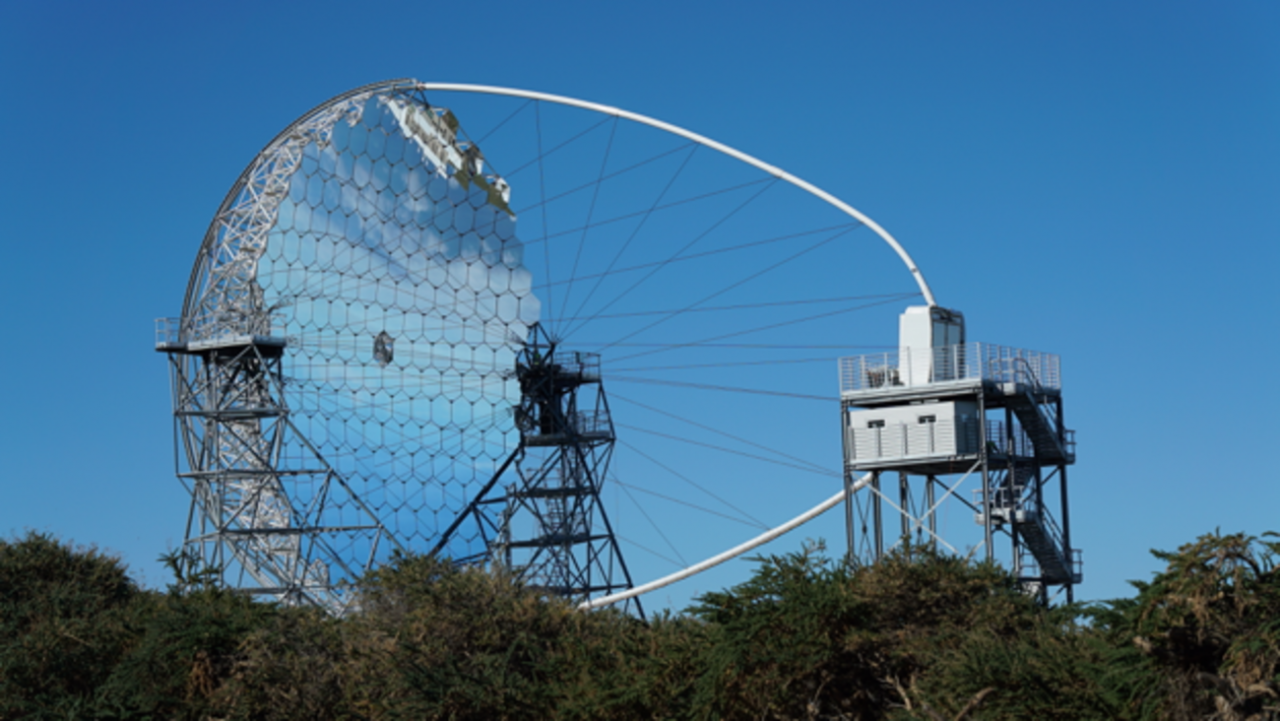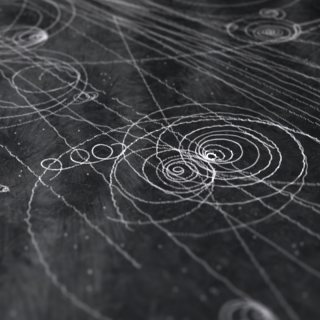Grants related:
General
The MAGIC Collaboration is integrated by 20 research institutes and university departments from Armenia, Bulgaria, Finland, Germany, Italy, Poland, Spain, Switzerland and USA. The collaboration comprises two 17m diameter telescopes, located at the Roque de los Muchachos Observatory, designed to measure the Cherenkov radiation associated with atmospheric showers from very high-energy gamma rays.
CTA is a major international collaboration for building two large Cherenkov observatories at North and South Hemispheres. Roque de los Muchachos Observatory in La Palma has been selected to host the Northern observatory. The first large size telescope was inaugurated in October 2018, and we are presently building the other three.
Members
Results
- Inauguration of the first large-size telescope of CTA (LST-1) at the Observatorio del Roque de Los Muchachos
- Detection of a neutrino generated in a blazar with MAGIC, IcCube and Fermi-LAT
- Discovery of the binary systemPSR J2032+4127/MT91 213 emitting in VHE gamma rays.
Scientific activity
Related publications
-
Search for Gamma-Ray Spectral Lines from Dark Matter Annihilation up to 100 TeV toward the Galactic Center with MAGIC
Linelike features in TeV γ rays constitute a "smoking gun" for TeV-scale particle dark matter and new physics. Probing the Galactic Center region with ground-based Cherenkov telescopes enables the search for TeV spectral features in immediate association with a dense dark matter reservoir at a sensitivity out of reach for satellite γ -ray detectors
Abe, H. et al.Advertised on:
22023 -
Long-term multi-wavelength study of 1ES 0647+250
Context. The BL Lac object 1ES 0647+250 is one of the few distant γ-ray emitting blazars detected at very high energies (VHEs; ≳100 GeV) during a non-flaring state. It was detected with the MAGIC telescopes during a period of low activity in the years 2009−2011 as well as during three flaring activities in the years 2014, 2019, and 2020, with the
MAGIC Collaboration et al.Advertised on:
22023 -
Study of the GeV to TeV morphology of the γ Cygni SNR (G 78.2+2.1) with MAGIC and Fermi-LAT. Evidence for cosmic ray escape
Context. Diffusive shock acceleration (DSA) is the most promising mechanism that accelerates Galactic cosmic rays (CRs) in the shocks of supernova remnants (SNRs). It is based on particles scattering caused by turbulence ahead and behind the shock. The turbulence upstream is supposedly generated by the CRs, but this process is not well understood
MAGIC Collaboration et al.Advertised on:
22023 -
Optical spectroscopy of blazars for the Cherenkov Telescope Array - II
Active galactic nuclei (AGNs) make up about 35 per cent of the more than 250 sources detected in very high-energy (VHE) gamma rays to date with the imaging atmospheric Cherenkov telescopes. Apart from four nearby radio galaxies and two AGNs of unknown type, all known VHE AGNs are blazars. Knowledge of the cosmological redshift of gamma-ray blazars
Kasai, E. et al.Advertised on:
12023 -
Multiwavelength periodicity search in a sample of γ-ray bright blazars
We present the results of a long-term periodicity search in a sample of γ-ray blazars within a multiwavelength context. These blazars have been selected from the Steward Observatory sample as part of its optical monitoring program between 2008 and 2018. We study 15 sources with a temporal coverage in their optical total and polarized emission
Otero-Santos, J. et al.Advertised on:
22023 -
Periodicities in the Daily Proton Fluxes from 2011 to 2019 Measured by the Alpha Magnetic Spectrometer on the International Space Station from 1 to 100 GV
We present the precision measurement of the daily proton fluxes in cosmic rays from May 20, 2011 to October 29, 2019 (a total of 2824 days or 114 Bartels rotations) in the rigidity interval from 1 to 100 GV based on 5.5 ×10 9 protons collected with the Alpha Magnetic Spectrometer aboard the International Space Station. The proton fluxes exhibit
Aguilar, M. et al.Advertised on:
122021 -
Observation of the Gamma-Ray Binary HESS J0632+057 with the H.E.S.S., MAGIC, and VERITAS Telescopes
The results of gamma-ray observations of the binary system HESS J0632 + 057 collected during 450 hr over 15 yr, between 2004 and 2019, are presented. Data taken with the atmospheric Cherenkov telescopes H.E.S.S., MAGIC, and VERITAS at energies above 350 GeV were used together with observations at X-ray energies obtained with Swift-XRT, Chandra, XMM
Adams, C. B. et al.Advertised on:
122021 -
Search for Very High-energy Emission from the Millisecond Pulsar PSR J0218+4232
PSR J0218+4232 is one of the most energetic millisecond pulsars known and has long been considered as one of the best candidates for very high-energy (VHE; >100 GeV) γ-ray emission. Using 11.5 yr of Fermi Large Area Telescope (LAT) data between 100 MeV and 870 GeV, and ~90 hr of Major Atmospheric Gamma Imaging Cherenkov (MAGIC) observations in the
Acciari, V. A. et al.Advertised on:
122021 -
Investigation of the correlation patterns and the Compton dominance variability of Mrk 421 in 2017
Aims: We present a detailed characterisation and theoretical interpretation of the broadband emission of the paradigmatic TeV blazar Mrk 421, with a special focus on the multi-band flux correlations. Methods: The dataset has been collected through an extensive multi-wavelength campaign organised between 2016 December and 2017 June. The instruments
MAGIC Collaboration et al.Advertised on:
112021 -
Catalog of Long-term Transient Sources in the First 10 yr of Fermi-LAT Data
We present the first Fermi Large Area Telescope (LAT) catalog of long-term γ-ray transient sources (1FLT). This comprises sources that were detected on monthly time intervals during the first decade of Fermi-LAT operations. The monthly timescale allows us to identify transient and variable sources that were not yet reported in other Fermi-LAT
Baldini, L. et al.Advertised on:
92021 -
First detection of VHE gamma-ray emission from TXS 1515-273, study of its X-ray variability and spectral energy distribution
We report here on the first multiwavelength (MWL) campaign on the blazar TXS 1515-273, undertaken in 2019 and extending from radio to very-high-energy gamma-rays (VHE). Up until now, this blazar had not been the subject of any detailed MWL observations. It has a rather hard photon index at GeV energies and was considered a candidate extreme high
Acciari, V. A. et al.Advertised on:
102021 -
Properties of a New Group of Cosmic Nuclei: Results from the Alpha Magnetic Spectrometer on Sodium, Aluminum, and Nitrogen
We report the properties of sodium (Na) and aluminum (Al) cosmic rays in the rigidity range 2.15 GV to 3.0 TV based on 0.46 million sodium and 0.51 million aluminum nuclei collected by the Alpha Magnetic Spectrometer experiment on the International Space Station. We found that Na and Al, together with nitrogen (N), belong to a distinct cosmic ray
Aguilar, M. et al.Advertised on:
72021 -
Multiwavelength variability and correlation studies of Mrk 421 during historically low X-ray and γ-ray activity in 2015-2016
We report a characterization of the multiband flux variability and correlations of the nearby (z = 0.031) blazar Markarian 421 (Mrk 421) using data from Metsähovi, Swift, Fermi-LAT, MAGIC, FACT, and other collaborations and instruments from 2014 November till 2016 June. Mrk 421 did not show any prominent flaring activity, but exhibited periods of
Ansoldi, S. et al.Advertised on:
62021 -
H.E.S.S. and MAGIC observations of a sudden cessation of a very-high-energy γ-ray flare in PKS 1510‒089 in May 2016
The flat spectrum radio quasar (FSRQ) PKS 1510‒089 is known for its complex multiwavelength behaviour and it is one of only a few FSRQs detected in very-high-energy (VHE, E > 100 GeV) γ rays. The VHE γ-ray observations with H.E.S.S. and MAGIC in late May and early June 2016 resulted in the detection of an unprecedented flare, which revealed, for
H. E. S. S. Collaboration, et al.Advertised on:
42021 -
VHE gamma-ray detection of FSRQ QSO B1420+326 and modeling of its enhanced broadband state in 2020
Context. QSO B1420+326 is a blazar classified as a flat-spectrum radio quasar (FSRQ). At the beginning of the year 2020, it was found to be in an enhanced flux state and an extensive multiwavelength campaign allowed us to trace the evolution of the flare. Aims: We search for very high-energy (VHE) gamma-ray emission from QSO B1420+326 during this
MAGIC Collaboration et al.Advertised on:
32021 -
Properties of Heavy Secondary Fluorine Cosmic Rays: Results from the Alpha Magnetic Spectrometer
Precise knowledge of the charge and rigidity dependence of the secondary cosmic ray fluxes and the secondary-to-primary flux ratios is essential in the understanding of cosmic ray propagation. We report the properties of heavy secondary cosmic ray fluorine F in the rigidity R range 2.15 GV to 2.9 TV based on 0.29 million events collected by the
Aguilar, M. et al.Advertised on:
22021 -
Electron-beam interaction with emission-line clouds in blazars
Context. An electron-positron beam escaping from the magnetospheric vacuum gap of an accreting black hole interacts with recombination-line photons from surrounding gas clouds. Inverse-Compton scattering and subsequent pair production initiate unsaturated electromagnetic cascades exhibiting a characteristic spectral energy distribution. Aims: By
Wendel, Christoph et al.Advertised on:
22021 -
The Alpha Magnetic Spectrometer (AMS) on the international space station: Part II - Results from the first seven years
The Alpha Magnetic Spectrometer (AMS) is a precision particle physics detector on the International Space Station (ISS) conducting a unique, long-duration mission of fundamental physics research in space. The physics objectives include the precise studies of the origin of dark matter, antimatter, and cosmic rays as well as the exploration of new
Aguilar, M. et al.Advertised on:
22021 -
MAGIC Observations of the Nearby Short Gamma-Ray Burst GRB 160821B
The coincident detection of GW170817 in gravitational waves and electromagnetic radiation spanning the radio to MeV gamma-ray bands provided the first direct evidence that short gamma-ray bursts (GRBs) can originate from binary neutron star (BNS) mergers. On the other hand, the properties of short GRBs in high-energy gamma-rays are still poorly
Acciari, V. A. et al.Advertised on:
22021 -
Properties of Iron Primary Cosmic Rays: Results from the Alpha Magnetic Spectrometer
We report the observation of new properties of primary iron (Fe) cosmic rays in the rigidity range 2.65 GV to 3.0 TV with 0.62 ×10 6 iron nuclei collected by the Alpha Magnetic Spectrometer experiment on the International Space Station. Above 80.5 GV the rigidity dependence of the cosmic ray Fe flux is identical to the rigidity dependence of the
Aguilar, M. et al.Advertised on:
12021



